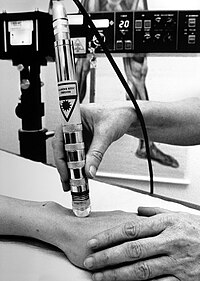
Photo from wikipedia
Brain photobiomodulation (PBM) therapy (PBMT) modulates various biological and cognitive processes in senescence rodent models. This study was designed to investigate the effects of transcranial near-infrared (NIR) laser treatment on… Click to show full abstract
Brain photobiomodulation (PBM) therapy (PBMT) modulates various biological and cognitive processes in senescence rodent models. This study was designed to investigate the effects of transcranial near-infrared (NIR) laser treatment on D-galactose (D-gal)/aluminum chloride (AlCl3) induced inflammation, synaptic dysfunction, and cognitive impairment in mice. The aged mouse model was induced by subcutaneously injecting D-gal (60 mg/kg/day) followed by intragastrically administering AlCl3 (200 mg/kg/day) for 2 months. NIR PBM (810 nm laser, 32, 16, and 8 J/cm2) was administered transcranially every other day (3 days/week) for 2 months. Social, contextual, and spatial memories were assessed by social interaction test, passive avoidance test, and Lashley III maze, respectively. Then, tumor necrosis factor-α (TNF-α), interleukin (IL)-6, and synaptic markers including growth-associated protein 43 (GAP-43), post-synaptic density-95 (PSD-95), and synaptophysin (SYN) levels were measured in the hippocampus using western blot method. Behavioral results revealed that NIR PBM at fluencies of 16 and 8 J/cm2 could reduce D-gal/AlCl3 impaired social and spatial memories. Treatment with NIR attenuated neuroinflammation through down-regulation of TNF-α and IL-6. Additionally, NIR significantly inhibited the down-regulation of GAP-43 and SYN. The results indicate that transcranial PBM at the fluencies 16 and 8 J/cm2 effectively prevents cognitive impairment in mice model of aging by inhibiting the production of the inflammatory cytokines and enhancing synaptic markers.
Journal Title: Lasers in Medical Science
Year Published: 2021
Link to full text (if available)
Share on Social Media: Sign Up to like & get
recommendations!